MEMS gyroscope is a device based on MEMS technology. MEMS is microelectromechanical system, which is the abbreviation of Micro-Electro-Mechanical Systems. MEMS technology is a great invention of the 21st century. It integrates mechanical components, optical systems, driving components and electronic control systems into a whole to design, process, measure and control micro/nano materials.
This article will introduce the working principle, classification, differences and parameters of MEMS gyroscope.
Working principle
The main theoretical basis of MEMS gyroscope is the Coriolis force, which is the tangential force experienced by a rotating object during radial motion. We can see the dynamic coordinate system from figure 1. The radial acceleration, Coriolis acceleration and centripetal acceleration can be calculated from the formulas (shows in figure 2).
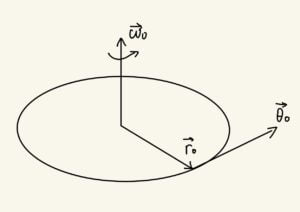
Figure 1. The dynamic coordinate system of Coriolis force
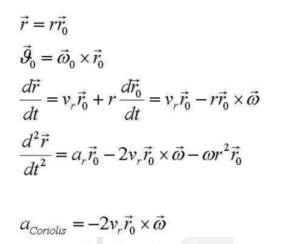
Figure 2. The formulas of the principle of Coriolis force
Coriolis force occurs when an object moves radially on a disk. This reflects the design principle of the MEMS gyroscope. The object is driven and constantly moves back and forth in the radial direction or oscillates. The corresponding Coriolis force also keeps changing back and forth in the lateral direction, which may cause the object to make small oscillations in the lateral direction. The difference between phase and driving force is 90 degrees, and figure 3 shows the driving direction.
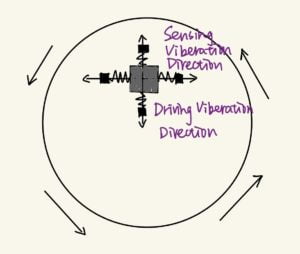
Figure 3. MEMS gyro driving and sensing
MEMS gyros usually have movable capacitive plates in two directions. The radial capacitive plate adds an oscillating voltage to make the object move in the radial direction. The transverse capacitive plate is used to measure the capacitance changes caused by the Coriolis force movement. This principle is similar to accelerometers measure acceleration. Since the Coriolis force is proportional to the angular velocity, the angular velocity can be calculated from the change in capacitance.
Performance classification
Not only are there many types of gyroscopes, MEMS gyros can also be divided into three types according to different performances.
1. Navigation grade MEMS gyroscope
Navigation grade is among the most accurate class of commercial gyroscopes. The navigation level is also the most expensive due to its high precision and very accurate output data. Navigation grade MEMS gyros are mostly used in aerospace, drones, oil logging, mining, surveying and mapping and other fields.
Ericco's MEMS gyros involve two product lines: navigation grade and tactical grade. For navigation grade gyroscopes, we design gyroscopes specifically for ground navigation and air navigation. For example, MG2-50/100 can be specially used for ground navigation, and the bias instability can reach 0.01-0.02°/hr. You can choose MG2-300/400 for air navigation, and the bias instability can reach 0.03-0.05° deg/hr.
2. Tactical grade MEMS gyroscope
Tactical-grade MEMS gyros are also used in a wide range of applications and are in high demand. They are a very cost-effective level. It is applied to drones, AHRS, robots, etc. The performance of tactical-grade MEMS gyros is very good and the cost is lower than that of navigation grade, making it a suitable choice if you want to control costs.
MG2-067 is a tactical-grade MEMS gyro, and its bias instability is <0.3°/hr.
3. Consumer grade MEMS gyroscope
Consumer grade is the lowest level among MEMS gyros. Its application scenarios are mostly automobiles, smartphones, etc. It can also be used in consumer grade IMUs. Since these fields do not have excessive requirements for accuracy,
Therefore, consumer grade gyroscopes usually have lower accuracy and lower cost.
The difference between three levels of gyroscopes
The biggest difference between them lies in the different parameters.
| Parameters | Navigation grade | Tactical grade | Consumer grade |
| Bias instability(°/h) | 0.01-0.09 | 0.1-15 | >15 |
| Angular random walk(°/√h) | 0.01-0.05 | 0.05-0.5 | >0.5 |
The basic explanation of these two parameters is as follows:
Bias instability: is a measure of how the bias drifts during operation at constant temperature over time
Angular random walk: represents the angular error accumulated over time due to white noise in the angular rate.
Other parameters
When choosing a MEMS gyro, you not only need to pay attention to the above two parameters, but also need to refer to several other parameters.
1. Measuring range: the maximum value of the input angular rate in the forward and reverse directions of the gyroscope represents the measuring range of the gyroscope. The larger the value, the more sensitive the gyroscope is.
2. Temperature: Ericco's MEMS gyros operate at −45°C to +85°C. Some fields, such as oil well logging, have higher requirements on the temperature of gyroscopes, so we need to evaluate whether the temperature of the gyroscope can meet the requirements based on actual application scenarios.
3. Size: Ericco's MEMS gyros are all 11x11x2mm in size, and some consumer grade gyroscopes may be smaller. For example, for well logging special-shaped probe tubes or small IMUs, the size of the gyroscope needs to be taken into consideration.
I hope that through this article you can learn something about how to choose a MEMS gyro. If you are interested in other knowledge about MEMS gyros, you can read the relevant articles below. If you want to learn about MEMS gyro products, you can click on the related products below.
More Technical Questions
1.MEMS gyroscope VS FOG: What’s the difference between them?
2.How accurate is MEMS gyroscope?
3.Where are MEMS Gyroscopes Used?
4.What is the Hardware Interface of Ericco MEMS Gyro
5.How to Configure the Register of Ericco MEMS Gyro
6.How to Distinguish MEMS Accelerometer and MEMS Gyroscope Correctly?
Products in Article


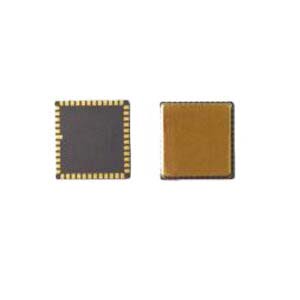
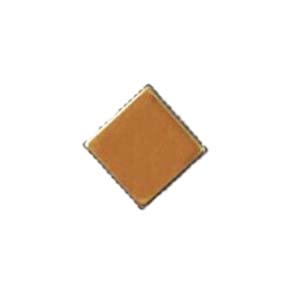

.jpg)

